#sdp40f
Text

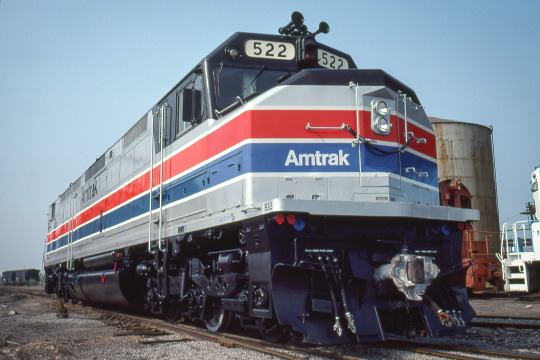
SDP40F in Phase II Paint
I assume this unit is from the initial batch of SDP40Fs from La Grange—beyond its fairly low number, it has the more complicated sheet metal work on the nose. (Later ones had a simplified design, with a flat section where the access door is located.)
The reason this locomotive is looking so marvelous—in Phase II paint—is that it has just come out of the Illinois Central Paducah shops after being refurbished. Too bad that the entire fleet of this model would be taken out of service later this very year or early the next due to a mysterious problem that caused it to derail with enough regularity that it was untenable.
The problem *may* have been due to large water tanks which were needed for the steam generator. (This locomotive was designed to haul legacy equipment that still used steam heat.) There's also a question about a newly designed truck. In any event there's never been a definitive reason for the issue. The engines would be returned to EMD which recycled some components in the manufacture of the F40PH for Amtrak; some of the units were reworked into freight locos that ran for the ATSF.
Two images by Richard Koenig; taken June 12, 1976.
50 notes
·
View notes
Text

Pressing onward through the Bitterroot mountains, Amtrak train No. 17 the Westbound North Coast Hiawatha powered by SDP40Fs No. 500 and No. 511 passes through the serene and picturesque pine forests, passengers aboard the train are treated to the sights of the forest.
Models and Route by: American Trainz Group, The Terminal Trainz, K&L Trainz, Track 29, Jointed Rail, Auran, and Download Station
Note: While this may not be that accurate to the real North Coast Hiawatha as seen in this video on Youtube: https://www.youtube.com/watch?v=Bb0UjkQZ87Q, but considering that this is set within Amtrak's rainbow era, I don't think it's all that of a big deal IMO. Also, the train in reality didn't run along this line even though it did run through Idaho, but the Avery-Drexel route was close enough.
#EMD#EMD SDP40F#Amtrak SDP40F#SDP40F#Amtrak#Amtrak Train#North Coast Hiawatha#Trainz Simulator#Trains
2 notes
·
View notes
Text
I don't link to RP much because I would rather get out there and do the work myself, and its better for my health to do so. Aside from that, a lot of these photographers' work can be found on glossy pages in bookstores, and you can go there and show your support if you like them that much. Once in a blue moon, however, something on there really grabs my eye. It is 2 years early for me to exist when this photo was taken, but as far as I'm concerned, this could be a self-portrait of my soul. Thanks Mr. Walker!
1 note
·
View note
Video
4/26/77, Amtrak SDP40F 585 by OHFalcon72
Via Flickr:
At the Burlington Northern shops in Denver, CO.
#amtk#amtrak#bn#burlington northern#1977#trains#passenger train#freight train#history#denver#colorado
32 notes
·
View notes
Text

Santa Fe - Argentine, KS
Santa Fe SDP40F No. 5254 (former Amtrak) and rebuilt U36C No. 9504 back into the engine terminal at Argentine Yard, in October 1986.
10 notes
·
View notes
Text
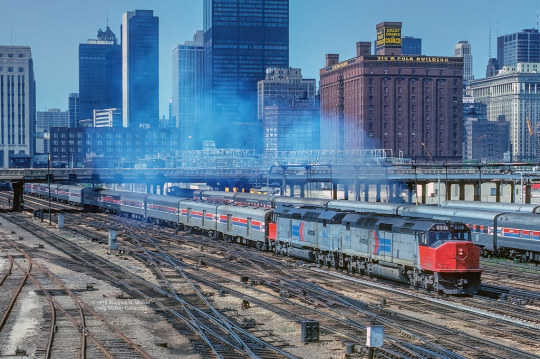
“On America’s 200th Birthday, Amtrak’s train 40, the eastbound Broadway Limited, departs downtown Chicago for Harrisburg, Pennsylvania, where the train will be split, with one section continuing on the Washington DC and the other section heading up to New York City. Two-year-old SDP40Fs 601 and 592 are in charge of this 12-car train, at least until Harrisburg, where each section will have the diesel changed to electric power – most likely a former-Pennsylvania Railroad GG-1 on each section.”
Chicago
July 4, 1976
Photo by Craig Walker
(via AMTK 601 • Chicago IL • 07/04/76 | On America’s 200th Birthd… | Flickr)
#trains#rr#railroad#railroads#rail#rails#train#illinois#tracks#track#chicago#trainspotting#Amtrak#bicentennial#july 4th#independence day#1976#1970s#urban#old chicago#locomotive#diesel locomotive#EMD#broadway limited#EMD SDP40F
74 notes
·
View notes
Note
The E60 is the forgotten child of Amtrak-bought six axle power. Everyone remembers the SDP40F and P30CH, but many forget about the E60
And their only 6 axel electrics too, amtrak was really hurting for new electric motive power back then
8 notes
·
View notes
Photo

This SDP was not your father's E unit. EMD was making a clean break from the original art deco inspired cab unit shape. This was to be the new cab unit shape that would last 25 years in the SDP40F- F40 models. This train is the southbound Merchants.
Attleboro, MA
August, 1975
#merchants limited#amtk#amtrak#1975#washington dc#boston#trains#passenger train#history#attleboro#massachusetts
6 notes
·
View notes
Video
Amtrak SDP40F 635 in February 1979 by Marty Bernard
Via Flickr:
A Roger Puta Photograph
4 notes
·
View notes
Text
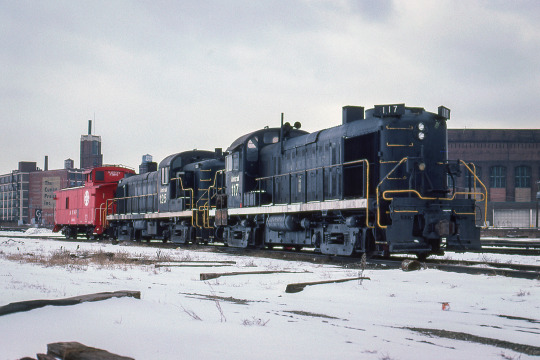
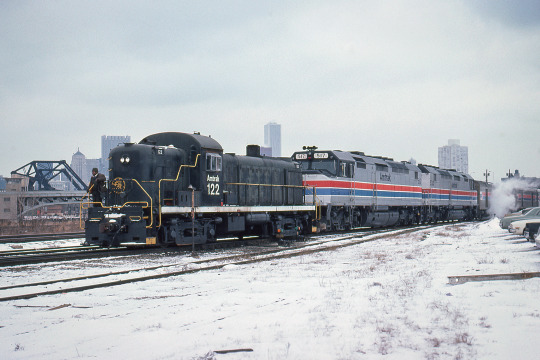
Legacy Equipment
Three Alco RS3s work the Amtrak facility in Chicago. Number 117 is ex-PC 5441, nee PRR 8441 (built November of 1953), number 125 is ex-PC 5502, nee NYC 8253 (built June of 1951), and number 122 is ex NH 523 (built August of 1950). The two SDP40Fs have recently had Phase II paint applied.
Two images by Richard Koenig; taken February 27th 1977.
34 notes
·
View notes
Photo

Day 23: EMD SDP40F
Info from Wikipedia:
The EMD SDP40F was a six-axle 3,000 hp (2.2 MW) C-C diesel–electric locomotive built by General Motors Electro-Motive Division (EMD) from 1973–1974. EMD built 150 for Amtrak, the operator of most intercity passenger trains in the United States. Amtrak, a private company but funded by the United States government, had begun operation in 1971 with a fleet of aging diesel locomotives inherited from various private railroads. The SDP40F was the first diesel locomotive built new for Amtrak and for a brief time they formed the backbone of the company's long-distance fleet.
A series of derailments in the mid-1970s shattered Amtrak's confidence in the locomotive, and many railroads banned it from their tracks. Multiple investigations pointed to issues with the locomotive's trucks, the weight of the water and steam generators used for train heating, or the harmonic vibration of baggage cars behind the locomotive. In 1977 Amtrak decided to move on from the SDP40F in favor of the EMD F40PH, which was already in use on short-distance routes. Amtrak traded most of its fleet into EMD; the components were incorporated into new F40PHs. The remainder were traded to the Atchison, Topeka and Santa Fe Railway (ATSF) for use in freight service. The Santa Fe rebuilt the locomotives and designated them SDF40-2. The Burlington Northern Santa Fe Railway (BNSF), successor to the Santa Fe, retired them in 2002. One of them is preserved.
Amtrak assumed operation of most intercity rail passenger service in the United States on May 1, 1971. Until then such services were operated by various private railroads. The private railroads chose to retain their second generation passenger locomotives for freight service, or to operate the various commuter services which, by law, did not pass to Amtrak. To operate these intercity services the Amtrak had to buy or lease from the private railroads whatever locomotives remained. This left Amtrak with an aging and mechanically-incompatible fleet of diesel locomotives. The mainstays of Amtrak's road diesel fleet were veteran E units and F units, which were 10–20 years old and due for replacement.
The SDP40F was a full-width cowl unit. It was based on the EMD FP45 passenger locomotive and EMD SD40-2 freight locomotive. All three shared the EMD 645E3 diesel prime mover, which developed 3,000 hp (2.2 MW). The locomotive had a gear ratio of 57:20. Maximum speed at full horsepower was 94 mph (151.3 km/h); the locomotive exceeded 100 miles per hour (160.9 km/h) in tests. There were doubts at the time about Amtrak's long-term viability, so the locomotives were designed for easy conversion to freight locomotives should Amtrak cease operation.
In the early 1970s Amtrak's passenger car fleet was steam-heated; Amtrak's requirement called for two steam generators. These were located at the rear of the locomotive. Forward of the generators was a 1,350-US-gallon (5,110.3 l; 1,124.1 imp gal) water tank. This tank rested above the floorline. The lateral motion of the water within was later implicated in several derailments. The primary underbody tank was split between water and diesel fuel, carrying 2,150 US gallons (8,138.6 l; 1,790.2 imp gal) of water and 2,500 US gallons (9,463.5 l; 2,081.7 imp gal) of diesel. Provision was made for eventual conversion to head-end power (HEP), but it was never carried out.
EMD based the SDP40F name on the existing SDP40. Several years earlier, EMD had made similar versions of the SDP45 and SD45 in a full-width cowl unit, which it named FP45 and F45. Although the SDP40F was externally nearly identical to the FP45, EMD chose not to give the new locomotive a similar name such as FP40. EMD wanted to avoid adding a new locomotive type to their catalog due to price controls in effect in the early 1970s. The following year, the F40C name was used for a similar locomotive ordered by the Chicago, Milwaukee, St. Paul and Pacific Railroad (the "Milwaukee Road"), equipped with HEP instead of steam generators.
There were several minor differences between the first 40 locomotives built and later examples. The most important was the installation of lower-profile cooling fans and air horns to avoid clearance problems in the Eastern US.
Amtrak ordered 150 SDP40Fs, in two batches. The first order, placed on November 2, 1972, was for 40 locomotives, at a cost of $18 million. A second order, for 110 locomotives at $50 million, followed on October 12, 1973. These orders were Amtrak's first for new-build locomotives.[18] Amtrak deployed the original 40 locomotives on long-distance trains in the Western United States. The locomotives entered revenue service on June 22, 1973, hauling the Super Chief from Chicago to Los Angeles over the Atchison, Topeka and Santa Fe Railway. SDP40Fs were also used on the Burlington Northern Railroad. The arrival of the second order enabled Amtrak to deploy the SDP40Fs throughout the country, displacing the inherited E-units.
In late 1975 J. David Ingles called the SDP40Fs the "stars of Amtrak's long-distance trains," but engine crews reported that the locomotives rode poorly compared to the E-units they had replaced. Even as Amtrak and EMD investigated the ride quality, the SDP40F was involved in a series of derailments that would lead to an end to its career as a passenger locomotive. Between 1974–1976 the Federal Railroad Administration (FRA) identified thirteen incidents for which the locomotive was responsible. None of the incidents were serious, but their frequency was a concern. Most of the derailments occurred on trains with two SDP40Fs on the front and at least one trailing baggage car. While the rear truck of the second locomotive and the front truck of the baggage car were pinpointed as the source of the derailment, the actual cause of the derailments was unclear.
EMD, Amtrak, the Association of American Railroads (AAR), and the FRA tested the locomotive thoroughly, with suspicion falling on the "hollow bolster" truck design. In the end, the investigators theorized that the steam generators and water tank may have made the rear of the engine too heavy and created too much lateral motion. Later FRA investigations concluded that the actual culprit was the light weight of the baggage cars, which caused harmonic vibrations when placed directly behind the much heavier SDP40F. A contributing factor was the sometimes poor quality of track the locomotive operated over.
Amtrak took several corrective measures, including operating with a reduced speed on curves, emptying the smaller of the two water tanks to reduce lateral motion, and making various alterations to the trucks. The measures helped, but the trouble continued. Several railroads, including the Burlington and the Chesapeake and Ohio Railway (C&O), banned the "rail breakers" from their tracks (they were suspected or known to be causing the spreading of rails because of their lateral swaying, which may have contributed to the derailments)[citation needed]. For the Chicago–Seattle Empire Builder, the speed restrictions added 6 hours to what had been a 46-hour schedule. Another important development was the unusually harsh winter of 1976–1977, which sidelined many of Amtrak's aging steam-heated coaches. Amtrak suspended numerous routes and pressed the new HEP-equipped Amfleet I coaches, designed for short runs, into service. The new EMD F40PH, intended for short-distance service and equipped with HEP, handled these trains.
In the spring of 1977 Amtrak faced a power crisis. In addition to the SDP40Fs derailing, Amtrak was having trouble with two other six-axle designs. The GE E60CP and E60CH electric locomotives were having derailment problems. The GE P30CH had the same truck design as E60s and rode poorly, although it did not exhibit the same tendency to derail. Amtrak decided to abandon the SDP40F in favor of the F40PH, a four-axle design with none of the riding problems of the six-axle locomotives. Amtrak traded 40 SDP40Fs back to EMD. Components including the prime mover were installed into an F40PH's frame. Between 1977–1987 Amtrak traded 132 of the SDP40Fs back to EMD for F40PHRs. The SDP40F remained in service on the Santa Fe longer than elsewhere, although the arrival of HEP-equipped Superliner cars on the Western routes displaced them from there as well. The last SDP40Fs left the Amtrak roster in 1987. The remaining Amtrak SDP40F's that weren't sold to the ATSF (seen below) are presumed to have been scrapped.
In 1984 Amtrak, low on light-duty power, traded 18 SDP40Fs to the Santa Fe for 43 switchers: 25 CF7s and 18 SSB1200s. Santa Fe rebuilt the traded locomotives for freight use. Modifications included removing the steam generators and regearing for lower speed. The locomotives were also given front steps and platforms, and notched noses in order to improve boarding access. The rebuilt locomotives were designated SDF40-2. The SDF40-2s continued in service with the BNSF Railway, successor to the Santa Fe, until their retirement in 2002.
One SDF40-2, ex-Amtrak No. 644, was acquired by Dynamic Rail Preservation Inc. and is in Boulder City, Nevada having been previously displayed in Ogden, Utah. It has been renumbered to its Santa Fe-era 6976 number and returned to operation in November 2019.
models and route by: American Trainz Group, trainzman54, Auran, and Download Station
#EMD#EMD SDP40F#Amtrak SDP40F#SDP40F#Amtrak#Diesel Locomotive#Trainz Simulator#Trains#Advent Calendar#Christmas#Christmas 2022 🎄🎅🎁
2 notes
·
View notes
Photo
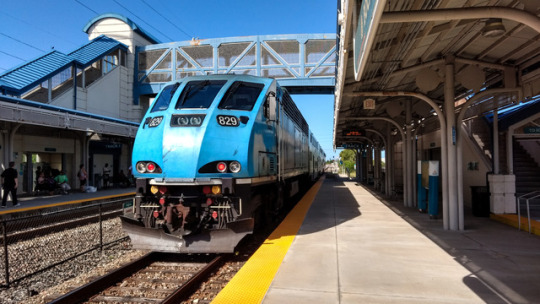
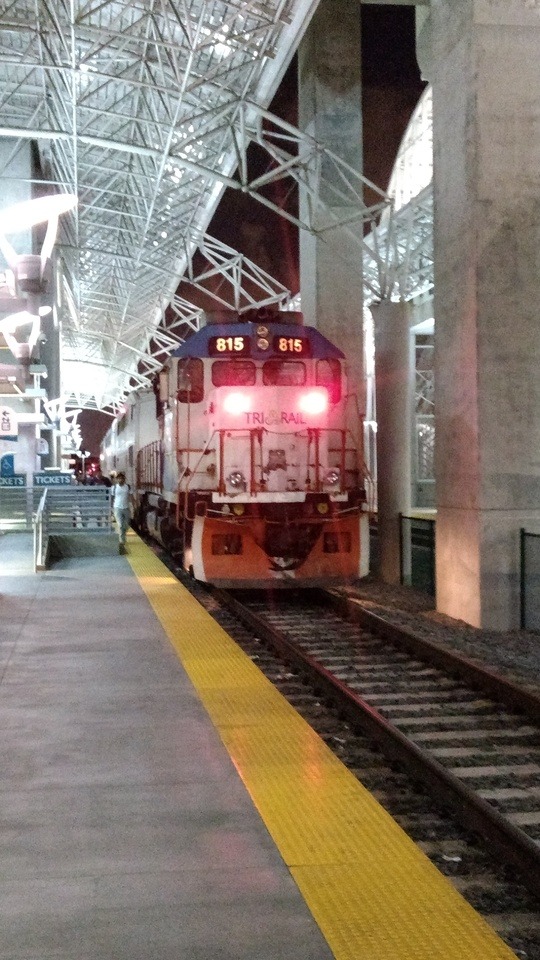
Commuter railroading in South Florida, 2017. Considering my feelings about Amtrak, I should like Cesar Vergara a lot, and exempting aesthetics, I do- he’s a great designer and he has lent his talents to an industry that needs good design but rarely has the cash or the flash to attract it. Despite the fact that he may have given the P42BH many of the characteristics that explain why most of the fleet (and possibly Amtrak itself) is still on the road today, I was downright disappointed when I first saw an AMD103, and the Brookville BL36PH on the left here, also one of his designs, shows why. A new passenger locomotive is such a rare opportunity to make a bold statement, and even in the darkest days for passenger trains in this country, EMD’s FP45′s, SDP40F’s and F40PH’s had a chiseled handsomeness that gave even the most pedestrian San Joaquins and Hiawathas the authority of Emilia Clarke riding a dragon. Vergara’s wedge-faced diesels, on the other hand, are too much function over form to me. I know that the engineer in that BL36PH probably loves that visibility and its probably great in any kind of weather, too, but the proportions of that windshield are completely off. Enough ranting, though: my treat for the evening was riding the last Southbound back to Miami behind screaming, fire-breathing GP49PH3 815, which despite having just a 12-cylinder prime mover (compared to the V20 + HEP genset in the BL36PH), made quite a bit more noise!
18 notes
·
View notes
Video
Erie Lackawanna RS-2 at McCook IL July 1977 by Mark LLanuza
Via Flickr:
We’re at Pilot Brother's Scrappers at McCook, IL. From the highway bridge gives a great view while your car is broken down of F-units, Alco's and Amtrak SDP40Fs.
#el#erie lackawanna#pc#penn central#amtk#amtrak#1977#trains#freight train#passenger train#history#mccook#illinois
35 notes
·
View notes
Text

Santa Fe - Argentine, KS
Santa Fe SD45Rs, Nos. 5327 and 5378 and former Amtrak SDP40F No. 5267 are seen at Argentine Yard, in October 1987.
#atsf#santa fe#bn#burlington northern#1987#trains#freight train#history#argentine yard#argentine#kansas city#kansas
4 notes
·
View notes
Text
N Scale Trains & Model Trains And Railroads
N Scale Trains & Model Trains And Railroads
Marc Tracy: Zach Collins was not a super-major a part of the Bulldogs team that made it to the championship game, and was a good smaller a part of the game itself, where they misplaced to North Carolina, 71-sixty five. The problem? But it’s also open-ended sufficient to allow for quite a lot of iterations going forward, even if the preliminary efforts fall a bit of flat, like a vegetable burrito with out guacamole. The one thing that makes the Sonic Producer better than a console is the variety of tracks that can be found on-line. Amongst burger chains, its shares have been higher than rivals akin to McDonald's (MCD) and Sonic (SONC). Steel buildings used as dairy barns could be designed to have enough ventilation by putting in ridge vents, circular vents, see on wikipedia and louvers. Can you send me the knowledge? Unfortunately, we didn't find adequate information whether or not Tellbostonmarket is protected for kids or does not look fraudulent. Unfortunately, the 12-ounce thermos solely holds a cost for two hours, so be sure you bring your charging coaster to work. God Save The Queen' and 'God Defend New Zealand' are the 2 official nationwide anthems of new Zealand. There just isn't an entire lot of taste to them, but that is not terribly stunning, as they are much lower in fat than TJ's beef meatballs.
There are some misconceptions about drinking milk and having other milk merchandise. He started to take a drink if ice tea and there was meals throughout the outside of the glass that was dried. Since the pizza was not a staple food service delivery, provide rights of these tried alternative ways to keep hot and chilly pies.Induction heating appears to be an effective option to transport contemporary food and keep prospects completely happy. Our service was good, not nice, however good. I hear promises that these of us on "Ultra" will see upgrades first, but I am solely going to attend so for much longer till I downgrade the service. site An issue with the sound card will undoubtedly be solved, solely by a computer technician. If labor costs rise dramatically, White Castle must steadiness its books by elevating prices or altering its enterprise model in order that it needs much less labor. This entails arising with an accurate marketing strategy.
In that case, it signifies that your Xbox 360 console is suffering with the dreaded red ring of demise drawback that effectively stops you from playing on it till it's fastened. The good news is, he was not the one that serving us or entertaining us.. Publisher: Devin Dozier The taste of pizzas at any cafe solely serving pizza Middletown MD is exclusive. To get the total story, check out my webpage (maybe you’d call it a weblog!) coping with the primary pizza maker: Pizza How to. I did not have to tug a single piece out of my mouth because it was inedible, which might be a first for me. The flavor is out of this world. Olive Garden Three Meat Sauce - this recipe was created out of one of the Never Ending Pasta Bowl sauces. The guy that delivered advised me he particularly reviewed the e-book for me too and took out a dressing I might ordered that isn't protected and changed with with gf ranch. For instance, the 290 calories and 17g of fats in a grilled steak tender taco are trimmed to just 170 calories and 5g of fat when ordered Fresco-model. Kato N Scale F7 Northern Pacific AB units are in stock, Kato N Scale SDP40F Amtrak PhaseII is right here!
Wichita State within the spherical of 32, and finally came up short versus eventual champion North Carolina, seventy five-73, within the Round of eight. We are journalistically obligated to say that his father has been beefing with LaVar Ball. It pains us that this record is just too short to incorporate quite a few our other favorites, which we feel belong here too. We particularly love their rice bowls and Fries; head here to read more. While the typical Velveeta-based mostly dip is easy and elastic in its cheesy richness, this cheddar-based mostly version has a grainy texture more paying homage to a roux-based sauce,” the publication ranted. A tall Frappucino blended coffee has 170 calories, whereas a venti has 340 calories, in response to the CalorieKing website. Here, you have to promise to have understood the Type N-400 and to have offered accurate responses. In all probability not, however that's all the hope I have right now, okay?
0 notes
Video
ATK Tr#20 @ Cajon by Kevin Cavanaugh
Via Flickr:
New SDP40F's are still 11 months away and leased Santa Fe F7A 311C and sisters, lead The Chief e/b through Cajon on a hot July 09, 1972. The 311C was repainted and re# in 1971 from the 45L at San Bernardino.
#the chief#amtk#amtrak#atsf#santa fe#1972#chicago#los angeles#trains#passenger train#history#cajon#california
35 notes
·
View notes
